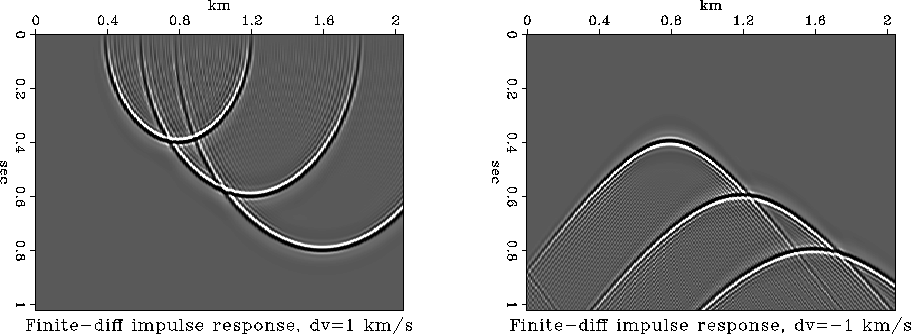 |
Figure 1 Impulse responses (Green's functions) of velocity continuation, computed by a second-order finite-difference method. The left plots corresponds to continuation to a larger velocity (+1 km/sec); the right plot, smaller velocity, (-1 km/sec).
In a recent work Fomel (1994, 1996), I introduced the process of velocity continuation to describe a continuous transformation of seismic time-migrated images with a change of the migration velocity. Velocity continuation generalizes the ideas of residual migration Etgen (1990); Rothman et al. (1985) and cascaded migrations Larner and Beasley (1987). In the zero-offset (post-stack) case, the velocity continuation process is governed by a partial differential equation in midpoint, time, and velocity coordinates, first discovered by Claerbout (1986b). Hubral et al. (1996) and Schleicher et al. (1997) describe this process in a broader context of ``image waves''. Generalizations are possible for the non-zero offset (prestack) case Fomel (1996, 1997).
A numerical implementation of velocity continuation process provides an efficient method of scanning the velocity dimension in the search of an optimally focused image. The first implementations Fomel (1996); Li (1986) used an analogy with Claerbout's 15-degree depth extrapolation equation to construct a finite-difference scheme with an implicit unconditionally stable advancement in velocity. Fomel and Claerbout (1997) presented an efficient three-dimensional generalization, applying the helix transform Claerbout (1997).
 |
A low-order finite-difference method is probably the most efficient numerical approach to this method, requiring the least work per velocity step. However, its accuracy is not optimal because of the well-known numerical dispersion effect. Figure 1 shows impulse responses of post-stack velocity continuation for three impulses, computed by the second-order finite-difference method Fomel (1996). As expected from the residual migration theory Rothman et al. (1985), continuation to a higher velocity (left plot) corresponds to migration with a residual velocity, and its impulse responses have an elliptical shape. Continuation to a smaller velocity (right plot in Figure 1) corresponds to demigration (modeling), and its impulse responses have a hyperbolic shape. The dispersion artifacts are clearly visible in the figure.
In this paper, I explore the possibility of implementing a numerical
velocity continuation by spectral methods. I adopted two different
methods, comparable in efficiency with finite differences. The first
method is a direct application of the Fast Fourier Transform (FFT)
technique. The second method transforms the time grid to Chebyshev
collocation points, which leads to an application of the
Chebyshev-![]() method Boyd (1989); Gottlieb and Orszag (1977); Lanczos (1956), combined with an
unconditionally stable implicit advancement in velocity. Both methods
employ a transformation of the grid from time t to the squared time
method Boyd (1989); Gottlieb and Orszag (1977); Lanczos (1956), combined with an
unconditionally stable implicit advancement in velocity. Both methods
employ a transformation of the grid from time t to the squared time
![]() , which removes the dependence on t from the
coefficients of the velocity continuation equation. Additionally, the
Fourier transform in the space (midpoint) variable x takes care of
the spatial dependencies. This transform is a major source of
efficiency, because different wavenumber slices can be processed
independently on a parallel computer before transforming them back to
the physical space.
, which removes the dependence on t from the
coefficients of the velocity continuation equation. Additionally, the
Fourier transform in the space (midpoint) variable x takes care of
the spatial dependencies. This transform is a major source of
efficiency, because different wavenumber slices can be processed
independently on a parallel computer before transforming them back to
the physical space.